Stanford Binet 1937 and
others
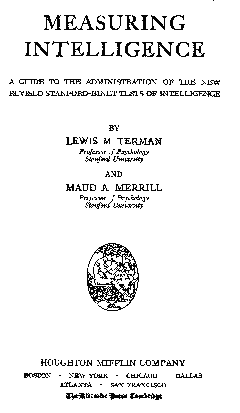 This
image is the title page of the 1937 Stanford-Binet Intelligence Scale for Children.
(The cover is blank). This test was highly sophisticated for its time, analogous
to a classic car. It had a representative standardization sample of 3,000 and
offered parallel forms (Form M and Form L; The forms were named after the test
creators). Portions of the sample were gathered in Indiana and Kentucky.
This
image is the title page of the 1937 Stanford-Binet Intelligence Scale for Children.
(The cover is blank). This test was highly sophisticated for its time, analogous
to a classic car. It had a representative standardization sample of 3,000 and
offered parallel forms (Form M and Form L; The forms were named after the test
creators). Portions of the sample were gathered in Indiana and Kentucky.
This quote from the manual
with regard to collecting the standardization sample gives a glimpse of the
era: "The problems of testing in rural communities are many and varied. At some
seasons of the year the roads in some of the rural sections were all but impassable;
the schools, most of them two- or three-room establishments, had few children
at exact ages [needed for the sample] and the next school district was many
rough miles away; homes where the pre-school children were tested were often
inaccessible and miles apart. Nevertheless, few of the children under fourteen
were missed, and the willingness of the teachers and parents to cooperate with
the "testing teacher" was very heartening. Indeed, we found everywhere in both
rural and urban communities a most cordial response and willing cooperation.
(p. 20)"
Comparing the sample characteristics
to modern tests illustrates the changing demographics and cultural sensitivities
of the United States. The 1937 sample (using 1930 census figures) was "all
American-born white children." They only discuss nationality of parentage
(50% were American-born and the vast majority of the remaining are of European
descent). This reflected the prevailing laws and attitudes regarding immigration,
as well as the vast influx of immigrants following WWI. A recent revision of
another intelligence measure (the Wechsler Intelligence Scale for Children-III)
used 1988 census figures to build a sample approximately 70% White, 15% Black,
and 11% Hispanic. Adapting to diversity is not merely an ideal but a reality
of modern American life.
For those interested, here
is the cover and title page of the 1960 Stanford-Binet revision (with 1972 norms).
This was a very child friendly (and examiner rough) individual intelligence
test.
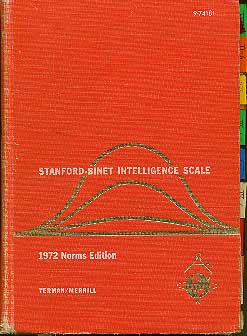
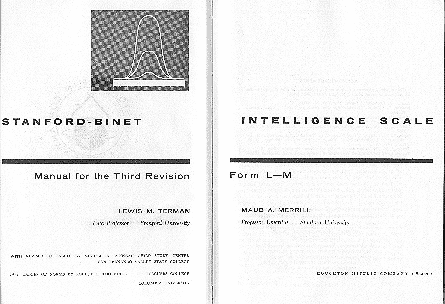
The latest version, the
4th edition, looks like this:
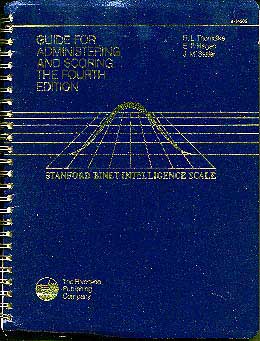
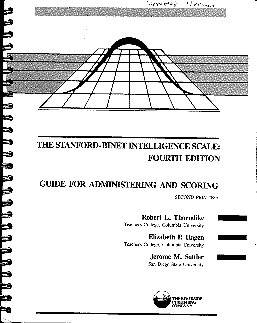
To learn more about the
the 4th edition
visit this link: http://edcen.ehhs.cmich.edu/~Emnesset/binet2.html
If you want to read the
original 1905
Binet version (translated into English) visit this link: http://psychclassics.asu.edu/Binet/intro.htm
For answers to Frequently
Asked Questions on Tests click here (testfaq.htm).
Psychology
Whimsies
Contact
the author with comments or questions about this site by following the directions
at this page (which will open in a new window.)
All
contents © since 1996 by Sally Kuhlenschmidt. Copy only with permission.
Website
created: June 1996. Page Created: March
1999; Last Modified: September 17, 2010.
 This
image is the title page of the 1937 Stanford-Binet Intelligence Scale for Children.
(The cover is blank). This test was highly sophisticated for its time, analogous
to a classic car. It had a representative standardization sample of 3,000 and
offered parallel forms (Form M and Form L; The forms were named after the test
creators). Portions of the sample were gathered in Indiana and Kentucky.
This
image is the title page of the 1937 Stanford-Binet Intelligence Scale for Children.
(The cover is blank). This test was highly sophisticated for its time, analogous
to a classic car. It had a representative standardization sample of 3,000 and
offered parallel forms (Form M and Form L; The forms were named after the test
creators). Portions of the sample were gathered in Indiana and Kentucky.



